It’s almost here! Only 9 days until AWS re:Invent 2021, and we’re very excited to share some highlights you might enjoy this year. The AI/ML team has been working hard to serve up some amazing content and this year, we have more session types for you to enjoy. Back in person, we now have chalk talks, workshops, builders’ sessions, and our traditional breakout sessions. Last year we hosted the first-ever machine learning (ML) keynote, and we are continuing the tradition. We also have more interactive and fun events happening with our AWS DeepRacer League and AWS BugBust Challenge. There are over 200 AI/ML sessions, including breakout sessions with customers such as Aon Corporation, Qualtrics, Shutterstock, and Bloomberg.
To help you plan your agenda for this year’s re:Invent, here are some highlights of the AI/ML track. You can also get the scoop from some of our AI/ML Community Heroes. So buckle up, and start registering for your favorite sessions.
Swami Sivasubramanian keynote
Wednesday, December 1, 8:30 am PT
Join Swami Sivasubramanian, Vice President, Machine Learning, AWS on an exploration of what it takes to put data in action with an end-to-end data strategy including the latest news on databases, analytics, and ML.
AI/ML leadership session with Bratin Saha
Wednesday, December 1, 4:00 pm PT
With the rise in compute power and data proliferation, ML has moved from the peripheral to being a core part of businesses and organizations across industries. AWS customers use ML and AI services to make accurate predictions, get deeper insights from their data, reduce operational overhead, improve customer experiences, and create entirely new lines of business. In this session, hear from Bratin Saha, Vice President, Machine Leaning, AWS and explore how AWS services can help you move from idea to production with ML.
AI/ML session preview
Here’s a preview of some of the different sessions we’re offering this year by session type. You can always log in to the event portal to favorite or register for any of these sessions, or search the catalog for over 200 other sessions available.
Breakout sessions
Prepare data for ML with ease, speed, and accuracy (AIM319)
Join this session to learn how to prepare data for ML in minutes using Amazon SageMaker. SageMaker offers tools to simplify data preparation so that you can label, prepare, and understand your data. Walk through a complete data-preparation workflow, including how to label training datasets using SageMaker Ground Truth, as well as how to extract data from multiple data sources, transform it using the prebuilt visualization templates in SageMaker Data Wrangler, and create model features. Also, learn how to improve efficiency by using SageMaker Feature Store to create a repository to store, retrieve, and share features.
Achieve high performance and cost-effective model deployment (AIM408)
To maximize your ML investments, high performance and cost-effective techniques are needed to scale model deployments. In this session, learn about the deployment options available in Amazon SageMaker, including optimized infrastructure choices; real-time, asynchronous, and batch inferences; multi-container endpoints; multi-model endpoints; auto scaling; model monitoring; and CI/CD integration for your ML workloads. Discover how to choose a better inference option for your ML use case. Then, hear from Goldman Sachs about how they use SageMaker for fast, low-latency, and scalable deployments to provide relevant research content recommendations for their clients.
Implementing MLOps practices with Amazon SageMaker, featuring Vanguard (AIM320)
Implementing MLOps practices helps data scientists and operations engineers collaborate to prepare, build, train, deploy, and manage models at scale. During this session, explore the breadth of MLOps features in Amazon SageMaker that help you provision consistent model development environments, automate ML workflows, implement CI/CD pipelines for ML, monitor models in production, and standardize model governance capabilities. Then, hear from Vanguard as they share their journey enabling MLOps to achieve ML at scale for their polyglot model development platforms using SageMaker features, including SageMaker projects, SageMaker Pipelines, SageMaker Model Registry, and SageMaker Model Monitor.
Enhancing the customer experience with Amazon Personalize (AIM204)
Personalizing content for a customer online is key to breaking through the noise. Yet, brands face challenges that often prevent them from providing these seamless, relevant experiences. Learn how easy it is to use Amazon Personalize to tailor product and content recommendations to ensure that your users are getting the content they want, leading to increased engagement and retention.
AI/ML for sustainability innovation: Insight at the edge (AIM207)
As climate change, wildlife conservation, public health, racial and economic equity, and new energy solutions become increasingly interdependent, scalable solutions are needed for actionable analysis at the intersection of these fields. In this session, learn how the power of AI/ML and IoT can be brought as close as possible to the challenging edge environments that provide data to create these insights. Also learn how AWS puts AI/ML in the hands of the largest-scale fisheries on the planet, and how organizations can leverage data to support more sustainable, resilient supply chains.
Get started with AWS computer vision services (AIM202)
This session provides an overview of AWS computer vision services and demonstrates how these pretrained and customizable ML capabilities can help you get started quickly—no ML expertise required. Learn how to deploy these models onto the device of your choice to run an inference locally or use cloud APIs for your specific computing needs. Learn first-hand how Shutterstock uses AWS computer vision services to create performance at scale for media analysis, content moderation, and quality inspection use cases.
Chalk talk sessions
Build an ML-powered demand planning system using Amazon Forecast (AIM310)
This chalk talk explores how you can use Amazon Forecast to build an ML-powered, fully automated demand planning system for your business or your multi-tenant SaaS platform without needing any ML expertise. Forecast automatically generates highly accurate forecasts using ML, explains the drivers behind those forecasts, and keeps your ML models always up to date to capture new trends.
Hello, is it conversational AI you’re looking for? (AIM305)
Customers calling in for support expect a personalized experience and a quick resolution to their issue. With chatbots, you can provide automated and human-like conversational experiences for your customers. In this chalk talk, discuss strategies to design personalized experiences using Amazon Lex and Amazon Polly. Explore how to design conversation paths, customize responses, integrate with your applications, and enable self-service use cases to scale your customer support functions.
Harness the power of ML to protect your business with Amazon Fraud Detector (AIM308)
How does more than 20 years of Amazon experience fighting fraud translate into an AI service that can help companies detect more online fraud faster? In this session, learn how Amazon Fraud Detector transforms raw data into highly accurate ML-based fraud detection models. Then, discover how the service does data preparation and validation, feature engineering, data enrichment, and model training and tuning. Finally, with actual customer examples across a wide range of industries and fraud use cases, find out how the service makes deployment easy.
Deep learning applications with PyTorch (AIM404)
By using PyTorch in Amazon SageMaker, you have a flexible deep learning framework combined with a fully managed ML solution that allows you to transition seamlessly from research prototyping to production deployment. In this session, hear from the PyTorch team on the latest features and library releases. Also, learn how to develop with PyTorch using SageMaker for key use cases, such as using a BERT model for natural language processing (NLP) and instance segmentation for fine-grained computer vision with distributed training and model parallelism.
Explore, analyze, and process data using Jupyter notebooks (AIM324)
Before using a dataset to train a model, you need to explore, analyze, and preprocess it. During this chalk talk, learn how to use Amazon SageMaker to complete these tasks in a Jupyter notebook environment.
Machine learning at the edge with Amazon SageMaker (AIM410)
More ML models are being deployed on edge devices such as robots and smart cameras. In this chalk talk, dive into building computer vision (CV) applications at the edge for predictive maintenance, industrial IoT, and more. Learn how to operate and monitor multiple models across a fleet of devices. Also walk through the process to build and train CV models with Amazon SageMaker and how to package, deploy, and manage them with SageMaker Edge Manager. The chalk talk also covers edge device setup and MLOps lifecycle with over-the-air model updates and data capture to the cloud.
Builders’ sessions
Build and deploy a custom computer vision model in 60 minutes (AIM314)
Amazon Rekognition Custom Labels is an automated ML feature that enables customers to quickly train their own custom models for detecting business-specific objects and scenes from images—no ML expertise is required. In this builders’ session, learn how to use Amazon Rekognition Custom Labels to build and deploy your own computer vision model and push it to an application to showcase inference on images from a camera feed. Bring your laptop and an AWS account.
Easily label training data for machine learning at scale (AIM406)
Join this session to learn how to create high-quality labels while also reducing your data labeling costs by up to 70%. This builders’ session walks through the different workflow options in Amazon SageMaker Ground Truth, such as automatic labeling and assistive labeling features like auto-segmentation and image label verification. It also details how to build highly accurate training datasets for company brand logos, so you can build an ML model for company brand protection.
Workshop sessions
Develop your ML project with Amazon SageMaker (AIM402)
In this workshop, learn how to develop a full ML project end to end with Amazon SageMaker. Start with data exploration and analysis, data cleansing, and feature engineering with SageMaker Data Wrangler. Then, store features in SageMaker Feature Store, extract features for training with SageMaker Processing, train a model with SageMaker training, and then deploy it with SageMaker hosting. Also, learn how to use SageMaker Studio as an IDE and SageMaker Pipelines for orchestrating the ML workflow.
End-to-end 3D machine learning on Amazon SageMaker (AIM414)
As lidar sensors become more accessible and cost-effective, customers increasingly use point cloud data in new spaces like autonomous driving, robotics, and augmented reality. The growing availability of lidar sensors has increased use of point cloud data for ML tasks like 3D object detection, segmentation, object synthesis, and reconstruction. This workshop features Amazon SageMaker Ground Truth and explains how to ingest raw 3D point cloud data, label it, train a 3D object detection model, and deploy the model. The model in this session will be trained on an autonomous vehicle dataset.
AI workflow automation for document processing (AIM316)
Mortgage packets have hundreds of documents in various layouts and formats. With ML, you can set up a document-processing pipeline to automate mortgage application workflows like extracting text from W2s, paystubs, and deeds; classifying documents; or using custom entity recognition to pull out specific data points. In this workshop, learn various ways to use optical character recognition (OCR), NLP, and human-in-the-loop services to build a document-processing pipeline to automate mortgage applications—saving time, reducing manual effort, and improving ROI for your organization.
Boost the value of your media content with ML-powered search (AIM315)
Consumers rely on content not only to entertain but also to educate and facilitate purchasing decisions. To meet this demand, media content production is exploding. However, the process of producing, distributing, and monetizing this content is often complex, expensive, and time-consuming. Applying artificial intelligence and ML capabilities like image and video analysis, audio transcription, machine translation, and text analytics can solve many of these problems. In this workshop, utilize ML to extract detailed metadata from content and make it available for search, discovery, and editing use cases.
Instantly detect and diagnose anomalies within your business data (AIM302)
Anomalies in business data often indicate potential issues or even opportunities. ML can help you detect anomalies and then act on them proactively. In this workshop, learn how Amazon Lookout for Metrics automatically detects anomalies across thousands of metrics in near-real time and reduces false alarms.
Join the first annual AWS BugBust re:Invent Challenge and help set a Guinness record
The largest code fixing challenge is here! Python and Java developers of all skill levels can compete to fix software bugs, earn points, and win an array of prizes including Amazon Echo Dots, hoodies, and the grand prize of $1,500 USD. As you bust bugs, you also become part of an attempt to set the record for the largest bug fixing challenge with the Guinness World Records. All registered participants who fix even one bug will receive exclusive prizes and a certificate from AWS and Guinness to commemorate their contribution. Let the bug busting begin! You can join the challenge virtually or in-person at the AWS BugBust Hub in the main expo. Register now for free.
AWS DeepRacer: The fastest way to get rolling with machine learning
Developers of all skill levels from beginners to experts can get hands-on with ML by using AWS DeepRacer to train models in a cloud-based 3D racing simulator. Racers from virtually anywhere in the world can compete in the AWS DeepRacer League, the first global autonomous racing league driven by reinforcement learning. The race is on now! Sign in to AWS DeepRacer and compete in the AWS re:Invent Open for prizes and glory now through December 31, 2021. Tune in to the AWS DeepRacer League Championships on Twitch November 19 and 22 to see the 40 fastest developers of the 2021 season compete live. Learn from the best as they vie for a chance to advance to the Championship Cup Finale during Swami Sivasubramanian’s keynote on December 1, where they will race for their shot at $20,000 USD in cash prizes and the right to hoist the Championship Cup!
For those attending re:Invent in Las Vegas, don’t miss out on the opportunity to take your model from Sim2Real (simulation to reality) on the AWS DeepRacer Speedway inside the content hub at Caesar’s Forum. Upload your model and race a 1/18th scale autonomous RC car on a physical track. Stop by Tuesday afternoon to participate in the livestreamed wildcard race for a chance to win a trip back for re:Invent 2022. No model? No problem! The all-new AWS DeepRacer Arcade is available in the expo, where you can get literally get in the driver’s seat and take the wheel in this educational racing game. Take a spin on the virtual track and then compete against a featured AWS DeepRacer autonomous model in this arcade racing experience, with prizes and giveaways galore. Shift into the fast lane on your ML learning journey with AWS DeepRacer.
Head over to the re:Invent portal to build your schedule so you’re ready to hit the ground running. Be sure to stop by and talk to our experts at the AI/ML booth, or chat with the speakers after sessions. We can’t wait to see you in Las Vegas!
About the Authors
 Andrea Youmans is a Product Marketing Manager on the AI Services team at AWS. Over the past 10 years she has worked in the technology and telecommunications industries, focused on developer storytelling and marketing campaigns. In her spare time, she enjoys heading to the lake with her husband and Aussie dog Oakley, tasting wine and enjoying a movie from time to time.
Andrea Youmans is a Product Marketing Manager on the AI Services team at AWS. Over the past 10 years she has worked in the technology and telecommunications industries, focused on developer storytelling and marketing campaigns. In her spare time, she enjoys heading to the lake with her husband and Aussie dog Oakley, tasting wine and enjoying a movie from time to time.

 Paxton Hall is a Marketing Program Manager for the AWS AI/ML Community on the AI/ML Education team at AWS. He has worked in retail and experiential marketing for the past 7 years, focused on developing communities and marketing campaigns. Out of the office, he’s passionate about public lands access and conservation, and enjoys backcountry skiing, climbing, biking, and hiking throughout Washington’s Cascade mountains.
Paxton Hall is a Marketing Program Manager for the AWS AI/ML Community on the AI/ML Education team at AWS. He has worked in retail and experiential marketing for the past 7 years, focused on developing communities and marketing campaigns. Out of the office, he’s passionate about public lands access and conservation, and enjoys backcountry skiing, climbing, biking, and hiking throughout Washington’s Cascade mountains.




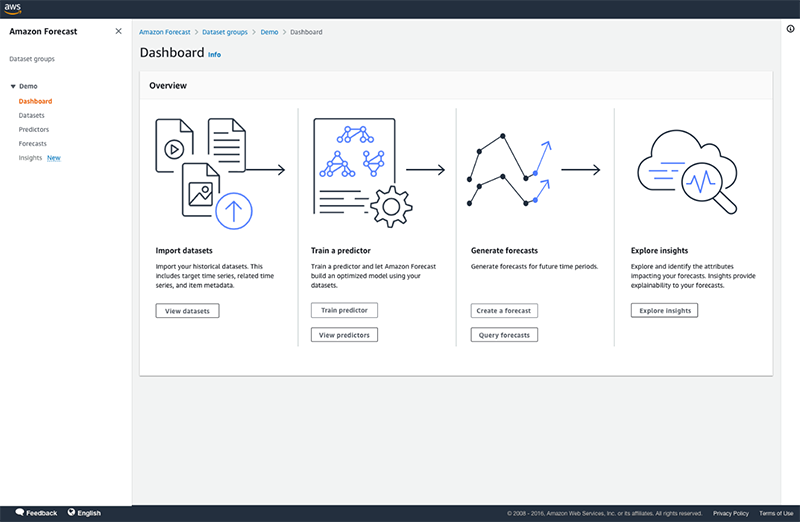





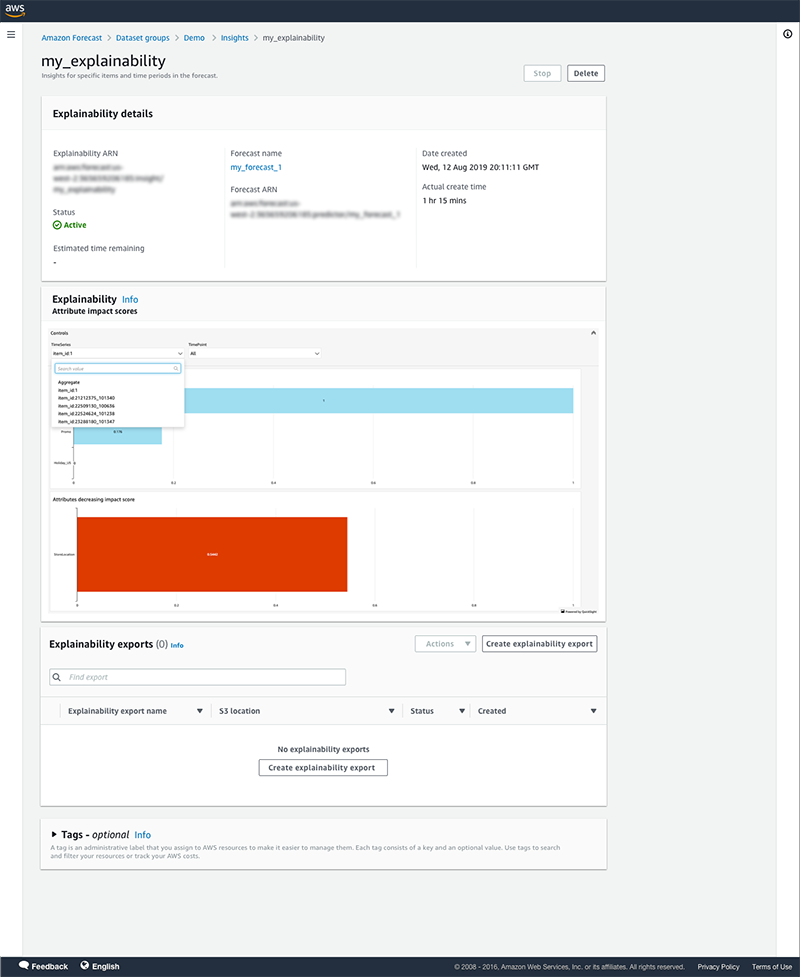


 Namita Das is a Sr. Product Manager for Amazon Forecast. Her current focus is to democratize machine learning by building no-code/low-code ML services. On the side, she frequently advises startups and loves training her dog with new tricks.
Namita Das is a Sr. Product Manager for Amazon Forecast. Her current focus is to democratize machine learning by building no-code/low-code ML services. On the side, she frequently advises startups and loves training her dog with new tricks. Dima Fayyad is a Software Development Engineer on the Amazon Forecast team. She is passionate about machine learning and AI and is currently working on large-scale distributed systems in the forecasting space. In her free time, she enjoys exploring different cuisines, traveling, and skiing.
Dima Fayyad is a Software Development Engineer on the Amazon Forecast team. She is passionate about machine learning and AI and is currently working on large-scale distributed systems in the forecasting space. In her free time, she enjoys exploring different cuisines, traveling, and skiing. Youngsuk Park is a Machine Learning Scientist at AWS AI and Amazon Forecast. His research lies in the interplay between machine learning, optimization, and decision-making, with over 10 publications in top-notch ML/AI venues. Before joining AWS, he obtained a PhD from Stanford University.
Youngsuk Park is a Machine Learning Scientist at AWS AI and Amazon Forecast. His research lies in the interplay between machine learning, optimization, and decision-making, with over 10 publications in top-notch ML/AI venues. Before joining AWS, he obtained a PhD from Stanford University. Shannon Killingsworth is a UX Designer for Amazon Forecast. His current work is creating console experiences that are usable by anyone, and integrating new features into the console experience. In his spare time, he is a fitness and automobile enthusiast.
Shannon Killingsworth is a UX Designer for Amazon Forecast. His current work is creating console experiences that are usable by anyone, and integrating new features into the console experience. In his spare time, he is a fitness and automobile enthusiast.

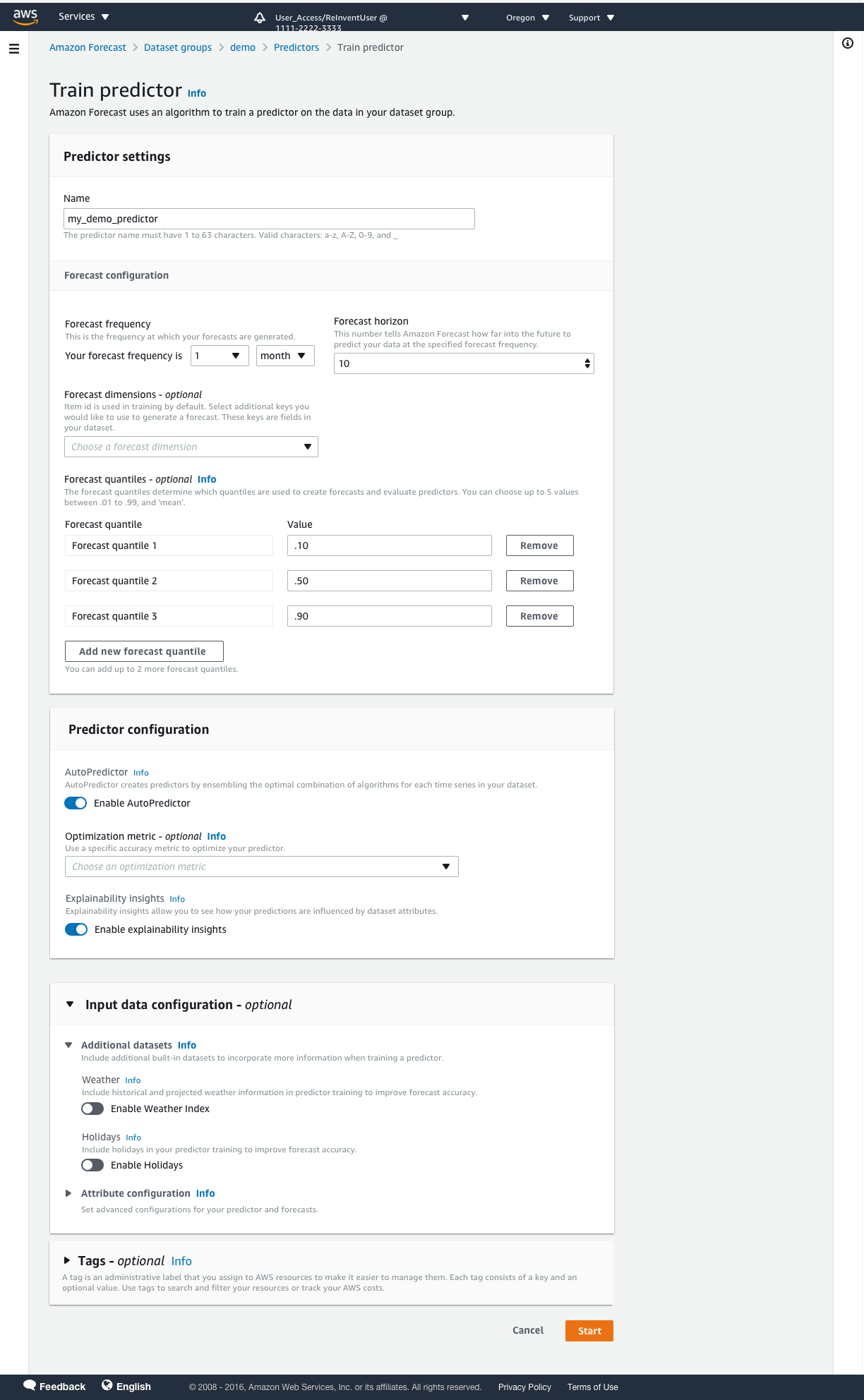


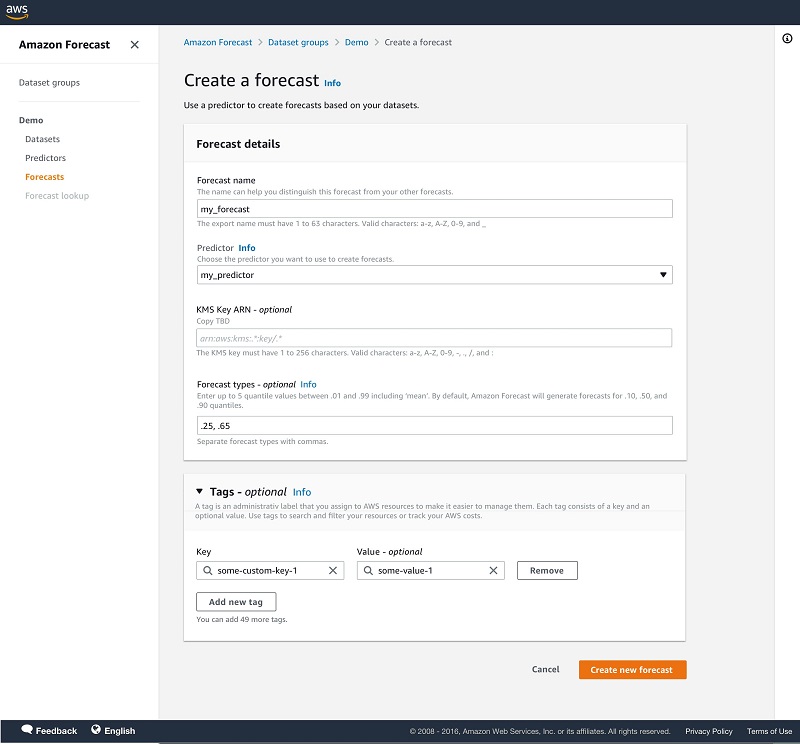

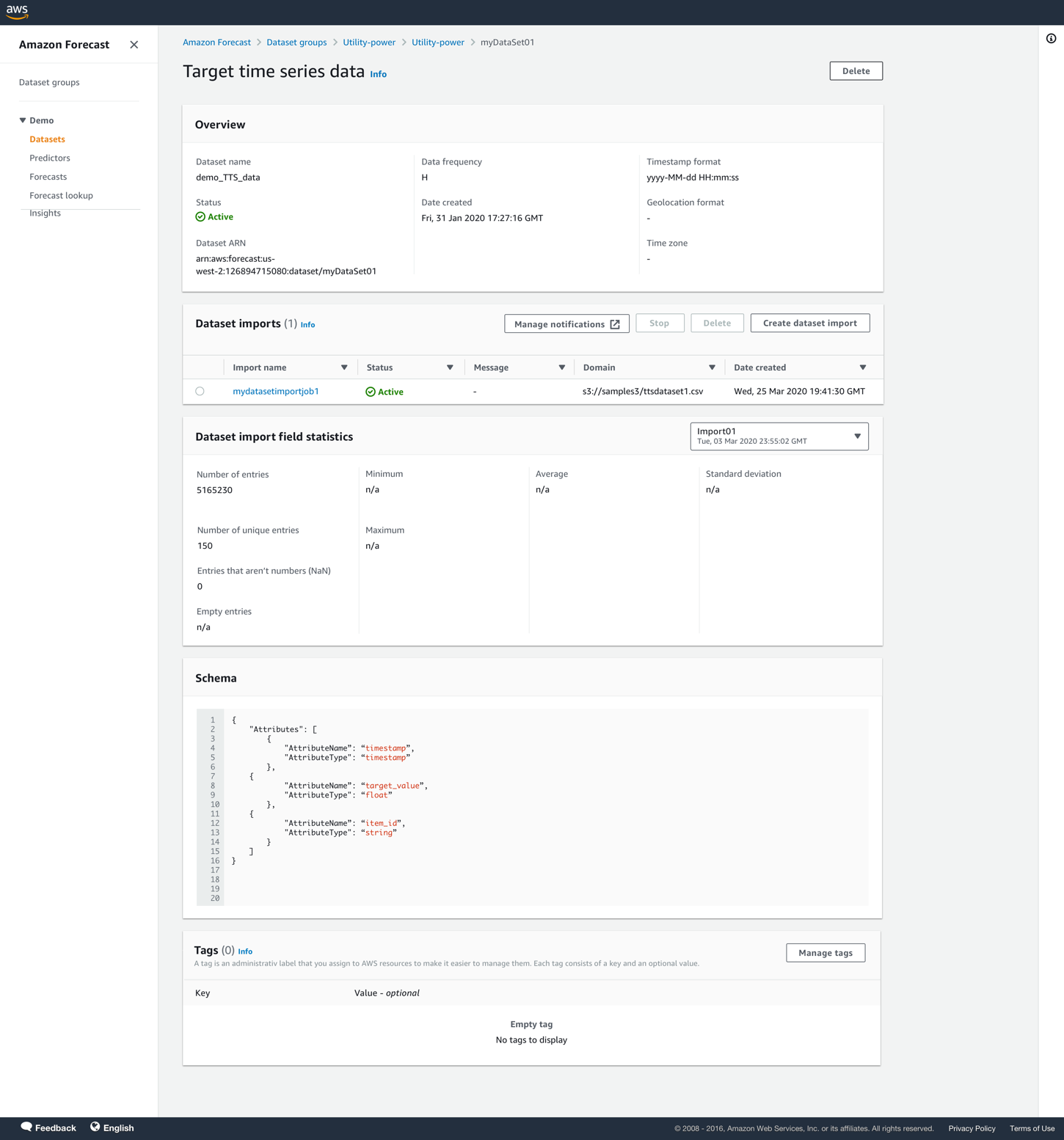






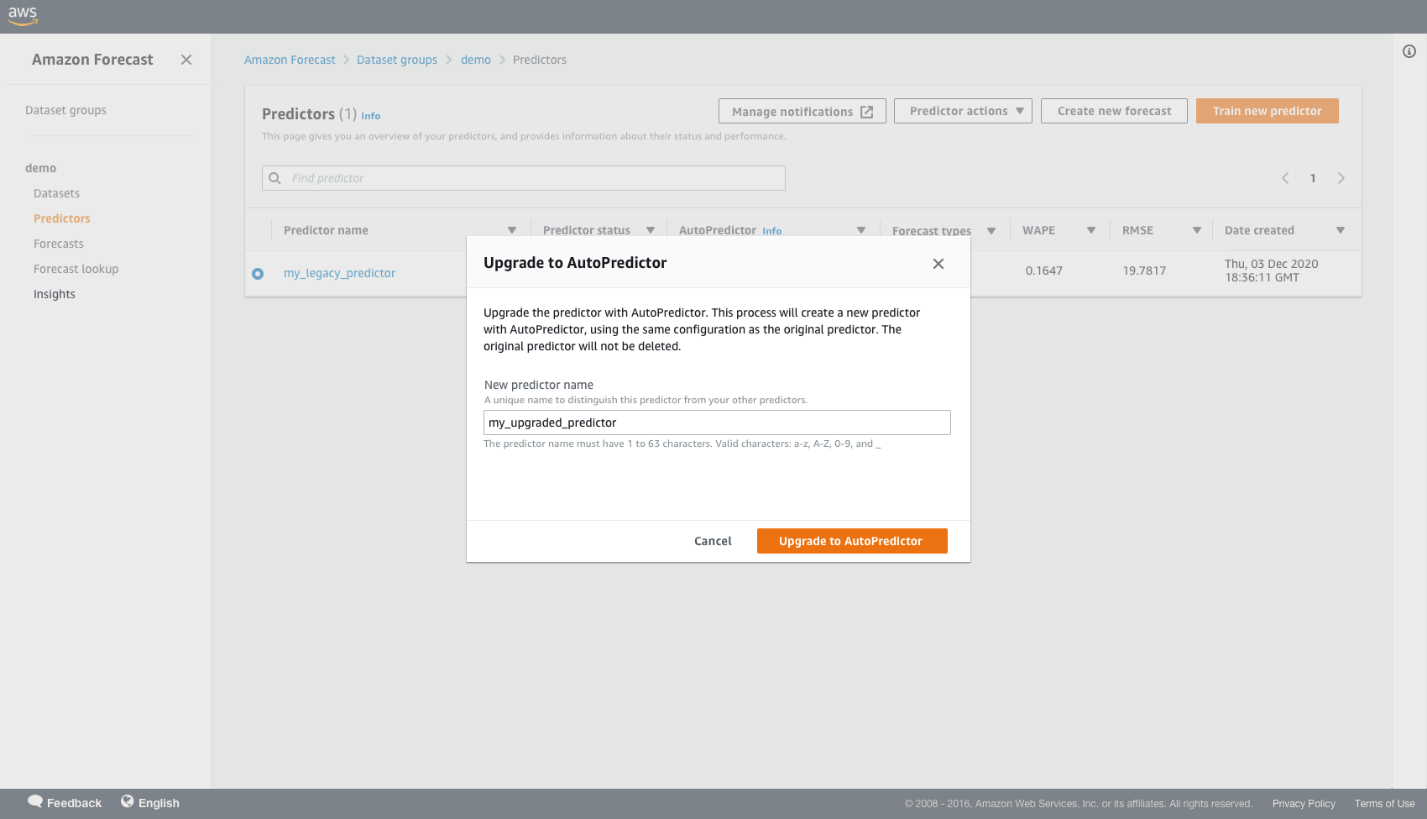



 Adarsh Singh works as a Software Development Engineer in the Amazon Forecast team. In his current role, he focuses on engineering problems and building scalable distributed systems that provide the most value to end users. In his spare time, he enjoys watching anime and playing video games.
Adarsh Singh works as a Software Development Engineer in the Amazon Forecast team. In his current role, he focuses on engineering problems and building scalable distributed systems that provide the most value to end users. In his spare time, he enjoys watching anime and playing video games. Chinmay Bapat is a Sr. Software Development Engineer in the Amazon Forecast team. His interests lie in the applications of machine learning and building scalable distributed systems. Outside of work, he enjoys playing board games and cooking.
Chinmay Bapat is a Sr. Software Development Engineer in the Amazon Forecast team. His interests lie in the applications of machine learning and building scalable distributed systems. Outside of work, he enjoys playing board games and cooking.
